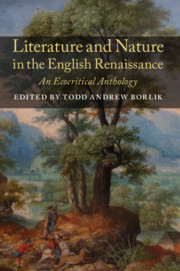Book contents
- Frontmatter
- Contents
- List of Illustrations
- Acknowledgements
- Editorial Principles: Towards the Ecocritical Editing of Renaissance Texts
- Introduction
- PART I Cosmologies
- PART II The Tangled Chain
- Hierarchy and the Human Animal
- Beasts
- Birds
- Fish
- Insects
- Plants
- Gems, Metals, Elements, Atoms
- PART III Time and Place
- PART IV Interactions
- PART V Environmental Problems in Early Modern England
- PART VI Disaster and Resilience in the Little Ice Age
- Appendix A Industrialization and Environmental Legislation in the Early Anthropocene: A Timeline
- Appendix B Further Reading: A Bibliography of Environmental Scholarship on the English Renaissance
Hierarchy and the Human Animal
from PART II - The Tangled Chain
Published online by Cambridge University Press: 05 June 2019
- Frontmatter
- Contents
- List of Illustrations
- Acknowledgements
- Editorial Principles: Towards the Ecocritical Editing of Renaissance Texts
- Introduction
- PART I Cosmologies
- PART II The Tangled Chain
- Hierarchy and the Human Animal
- Beasts
- Birds
- Fish
- Insects
- Plants
- Gems, Metals, Elements, Atoms
- PART III Time and Place
- PART IV Interactions
- PART V Environmental Problems in Early Modern England
- PART VI Disaster and Resilience in the Little Ice Age
- Appendix A Industrialization and Environmental Legislation in the Early Anthropocene: A Timeline
- Appendix B Further Reading: A Bibliography of Environmental Scholarship on the English Renaissance
Summary
“Monstrous” births are splayed across dozens of early modern broadsides and were even exhibited to a prurient public at markets and fairs. Most commentators agreed they were portents from an angry God; when an unwed woman in Kent gave birth in 1568 to a child described as leopard-mouthed it was deemed a stern warning against premarital sex. Various theories circulated as to how these anatomical anomalies were engendered. Some attributed it to witchcraft, as in the 1640 case of the Hog's-faced Gentlewoman Called Tannakin Skinker. Others held that the imagination of the parents during conception or pregnancy could produce defects, as exemplified by a fashion-obsessed mother who gave birth to a child with skinfolds around its neck resembling a ruff. Another common theory, outlined below by a renowned French physician, proposed that monstrous births were the result of bestiality. A 1533 Parliamentary Act declared bestiality (along with sodomy) a capital offence, and Assize Records document thirty cases from the Elizabethan period alone in which people were indicted for “buggery” with horses, cows, dogs, and sheep (Thomas 119). Few offenders, however, were prosecuted to the full extent of the law, which, in accordance with the Book of Leviticus, held the animal equally culpable. Since so many of the prodigious birth texts emphasize the bestial characteristics of the unfortunate child's appearance, the phenomenon was also a disturbing reminder of the precariousness of the animal/ human boundary, undercutting the conviction that humans were made in God's image.
Source: The Works of that Famous Surgeon Ambroise Paré, trans. Thomas Johnson (1634), 982–5.
That which followeth is a horrid thing to be spoken. But the chaste mind of the Reader will give me pardon and conceive that which not only the Stoics but all Philosophers who are busied about the search of the causes of things must hold: that there is nothing obscene or filthy to be spoken. Those things that are accounted obscene may be spoken without blame, but they cannot be acted or perpetrated without great wickedness, fury, and madness. Therefore, that ill which is in obscenity consists not in word but wholly in the act.
- Type
- Chapter
- Information
- Literature and Nature in the English RenaissanceAn Ecocritical Anthology, pp. 87 - 112Publisher: Cambridge University PressPrint publication year: 2019



